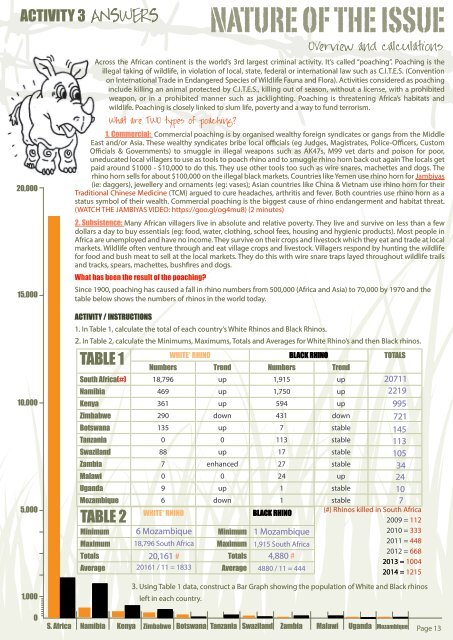Create successful ePaper yourself
Turn your PDF publications into a flip-book with our unique Google optimized e-Paper software.
ACTIVITY 3 ANSWERS<br />
NATURE OF THE ISSUE<br />
OVerview and calculations<br />
20,000<br />
15,000<br />
10,000<br />
5,000<br />
1,000<br />
Across the African continent is the world’s 3rd largest criminal activity. It’s called “poaching”. Poaching is the<br />
illegal taking of wildlife, in violation of local, state, federal or international law such as C.I.T.E.S. (Convention<br />
on International Trade in Endangered Species of Wildlife Fauna and Flora). Activities considered as poaching<br />
include killing an animal protected by C.I.T.E.S., killing out of season, without a license, with a prohibited<br />
weapon, or in a prohibited manner such as jacklighting. Poaching is threatening Africa’s habitats and<br />
wildlife. Poaching is closely linked to slum life, poverty and a way to fund terrorism.<br />
What are TWO types of poaching?<br />
1. Commercial: Commercial poaching is by organised wealthy foreign syndicates or gangs from the Middle<br />
East and/or Asia. These wealthy syndicates bribe local officials (eg Judges, Magistrates, Police-Officers, Custom<br />
Officials & Governments) to smuggle in illegal weapons such as AK47s, M99 vet darts and poison for poor,<br />
uneducated local villagers to use as tools to poach rhino and to smuggle rhino horn back out again The locals get<br />
paid around $1000 - $10,000 to do this. They use other tools too such as wire snares, machettes and dogs. The<br />
rhino horn sells for about $100,000 on the illegal black markets. Countries like Yemen use rhino horn for Jambiyas<br />
(ie: daggers), jewellery and ornaments (eg: vases); Asian countries like China & Vietnam use rhino horn for their<br />
Traditional Chinese Medicine (TCM) argued to cure headaches, arthritis and fever. Both countries use rhino horn as a<br />
status symbol of their wealth. Commercial poaching is the biggest cause of rhino endangerment and habitat threat.<br />
(WATCH THE JAMBIYAS VIDEO: https://goo.gl/og4mu8) (2 minutes)<br />
2. Subsistence: Many African villagers live in absolute and relative poverty. They live and survive on less than a few<br />
dollars a day to buy essentials (eg: food, water, clothing, school fees, housing and hygienic products). Most people in<br />
Africa are unemployed and have no income. They survive on their crops and livestock which they eat and trade at local<br />
markets. Wildlife often venture through and eat village crops and livestock. Villagers respond by hunting the wildlife<br />
for food and bush meat to sell at the local markets. They do this with wire snare traps layed throughout wildlife trails<br />
and tracks, spears, machettes, bushfires and dogs.<br />
What has been the result of the poaching?<br />
Since 1900, poaching has caused a fall in rhino numbers from 500,000 (Africa and Asia) to 70,000 by 1970 and the<br />
table below shows the numbers of rhinos in the world today.<br />
ACTIVITY / INSTRUCTIONS<br />
1. In Table 1, calculate the total of each country’s White Rhinos and Black Rhinos.<br />
2. In Table 2, calculate the Minimums, Maximums, Totals and Averages for White Rhino’s and then Black rhinos.<br />
TABLE 1<br />
WHITE* RHINO BLACK RHINO TOTALS<br />
Numbers Trend Numbers Trend<br />
South Africa(#) 18,796 up 1,915 up<br />
Namibia 469 up 1,750 up<br />
Kenya 361 up 594 up<br />
Zimbabwe 290 down 431 down<br />
Botswana 135 up 7 stable<br />
Tanzania 0 0 113 stable<br />
Swaziland 88 up 17 stable<br />
Zambia 7 enhanced 27 stable<br />
Malawi 0 0 24 up<br />
Uganda 9 up 1 stable<br />
Mozambique 6 down 1 stable<br />
TABLE 2<br />
Minimum<br />
Maximum<br />
Totals<br />
Average<br />
WHITE* RHINO<br />
6 Mozambique<br />
18,796 South Africa<br />
20,161 #<br />
20161 / 11 = 1833<br />
Minimum<br />
Maximum<br />
Totals<br />
Average<br />
BLACK RHINO<br />
3. Using Table 1 data, construct a Bar Graph showing the population of White and Black rhinos<br />
left in each country.<br />
1 Mozambique<br />
1,915 South Africa<br />
4,880 #<br />
4880 / 11 = 444<br />
20711<br />
2219<br />
995<br />
721<br />
145<br />
113<br />
105<br />
34<br />
24<br />
10<br />
7<br />
(#) Rhinos killed in South Africa<br />
2009 = 112<br />
2010 = 333<br />
2011 = 448<br />
2012 = 668<br />
2013 = 1004<br />
2014 = 1215<br />
0<br />
S. Africa Namibia Kenya Zimbabwe Botswana Tanzania Swaziland Zambia Malawi Uganda Mozambique<br />
Page 13



